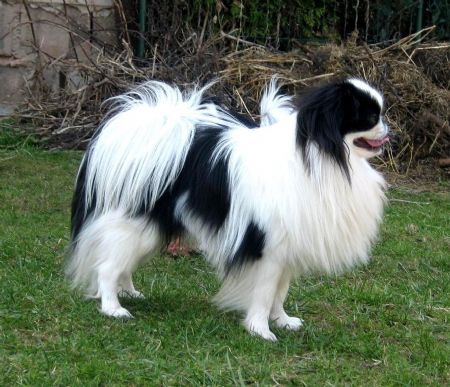Japanese Chin

Also known as the Chin or Japanese Spaniel.
This breed is considered one of the most cat-like of the dog breeds in attitude: it is alert, intelligent, and independent, and it uses its paws to wash and wipe its face. Other cat-like traits include their preference for resting on high surfaces.
Chin were bred for the purpose of loving and entertaining their people. While typically a calm little dog, they are well known for performing many enjoyable antics such as the "Chin Spin", in which they turn around in rapid circles; dancing on their hind legs while pawing their front feet, clasped together, in the air; and, some even "sing", a noise that can range from a low trill to a higher, almost operatic quality noise, and which sounds much like "woooo".
The origin of the Japanese Chin is clouded in the mysticism of Far Eastern ancient rites. Small dogs were known to have crisscrossed the Silk Road accompanying travelers as both presentations of trade and companions on the long journeys. Some of these dogs became the pets of Buddhist Monks, who nurtured and mated various types in their sheltered monasteries: eventually, gifts to traveling dignitaries. They quickly assumed their rightful position in the Imperial palaces, where they were closely kept and guarded for the Imperial family by private eunuchs who were charged with looking after the little dogs' every need, every desire. Mere peasants were not allowed to own them as the small dogs became treasures more valuable than gold.
The name Japanese Chin is actually a misnomer for the breed owes its basic origins not to Japan, but to China. It has long been surmised that the Japanese Chin and Pekingese were once the same breed with the Pekingese having been bred out to create the short, bowed-legged, long-back, pear-shape bodied breed of dog known today. The Chin is believed to have been kept basically pure, but in searching through Far Eastern works of art dating from the 17th to 20th Century, several patterns clearly emerge:
- an early small Japanese dog resembled the old Continental Toy Spaniel of Europe - aristocratic in bearing, square-bodied, up-on-the leg, distinctive long muzzle and luxurious flowing silky coat
- the Chinese Chin was the flat-faced, straight-legged, a bit long-backed, parti-color dog called the Imperial Chin
- these two types were blended together to bring about the Japanese Chin of today dainty, square-bodied, flat-faced, and richly coated, elegant toy breed.